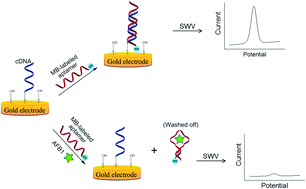A competitive electrochemical aptamer-based method for aflatoxin B1 detection with signal-off response†
Abstract
The authors described a competitive electrochemical aptamer-based method for detection of aflatoxin B1 (AFB1), one of the most toxic mycotoxins. In brief, a complementary DNA (cDNA) strand of an anti-AFB1 aptamer was immobilized on the surface of a gold electrode, and subsequently incubated with sample solution containing a methylene blue (MB)-labeled aptamer. In the absence of AFB1, the MB-labeled aptamer hybridized with the cDNA on the gold electrode, which brought MB close to the gold electrode surface, causing high current. When AFB1 existed in the sample solution, the MB-labeled aptamer bound with AFB1 instead of cDNA, and the amount of MB-labeled aptamer on the gold electrode decreased, so the current signal reduced. Under optimized experimental conditions, the sensor exhibited a detection limit of 2 nM AFB1 and a dynamic detection range of 2 nM to 500 nM. A simple incubation in hot water (85 °C) allowed quick regeneration of the electrochemical sensor. Successful detection of AFB1 spiked in white grape wine demonstrated the application potential of this electrochemical sensor in real-sample analysis.



 Please wait while we load your content...
Please wait while we load your content...